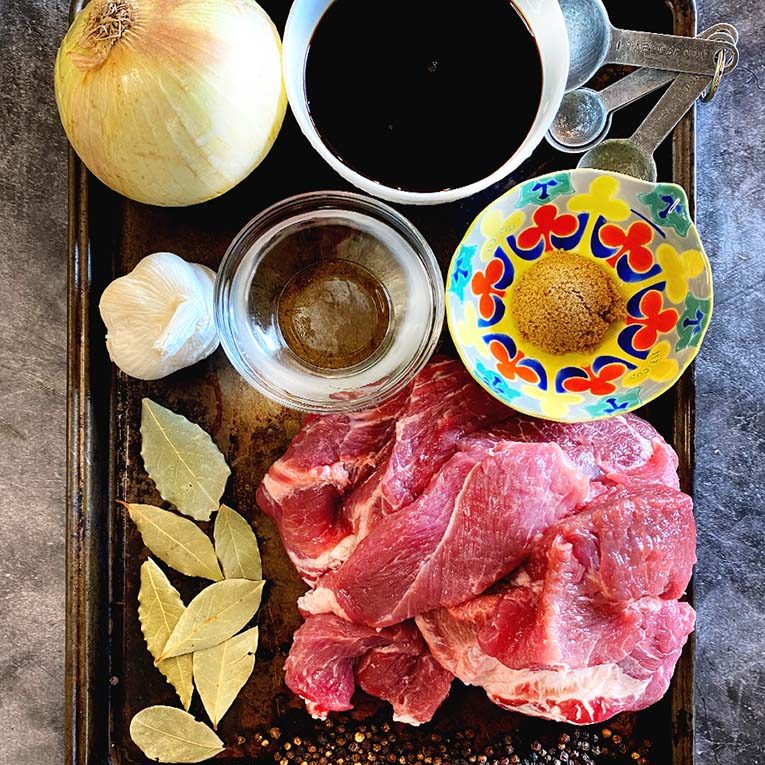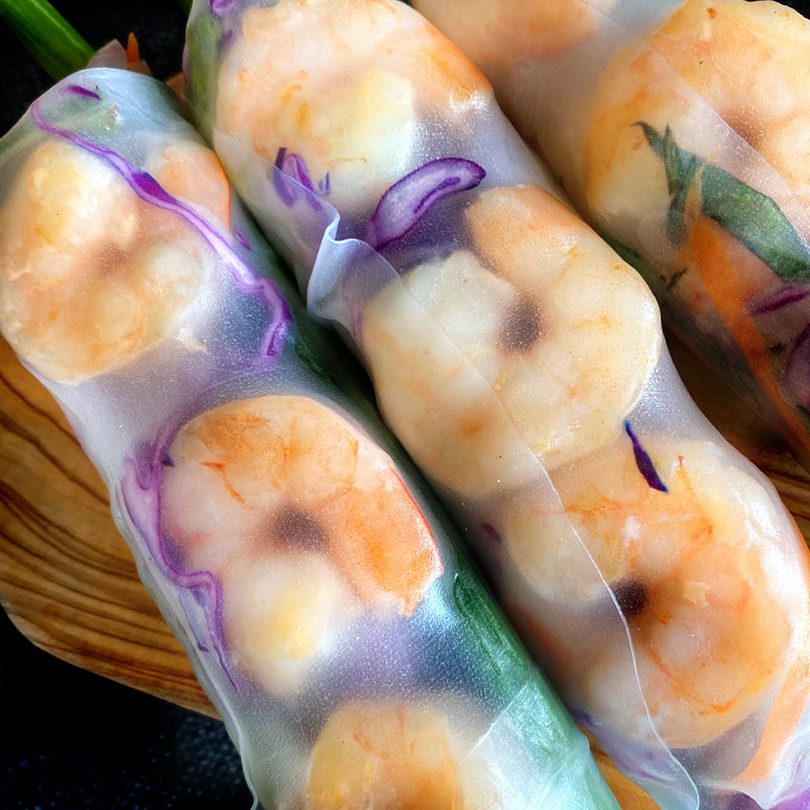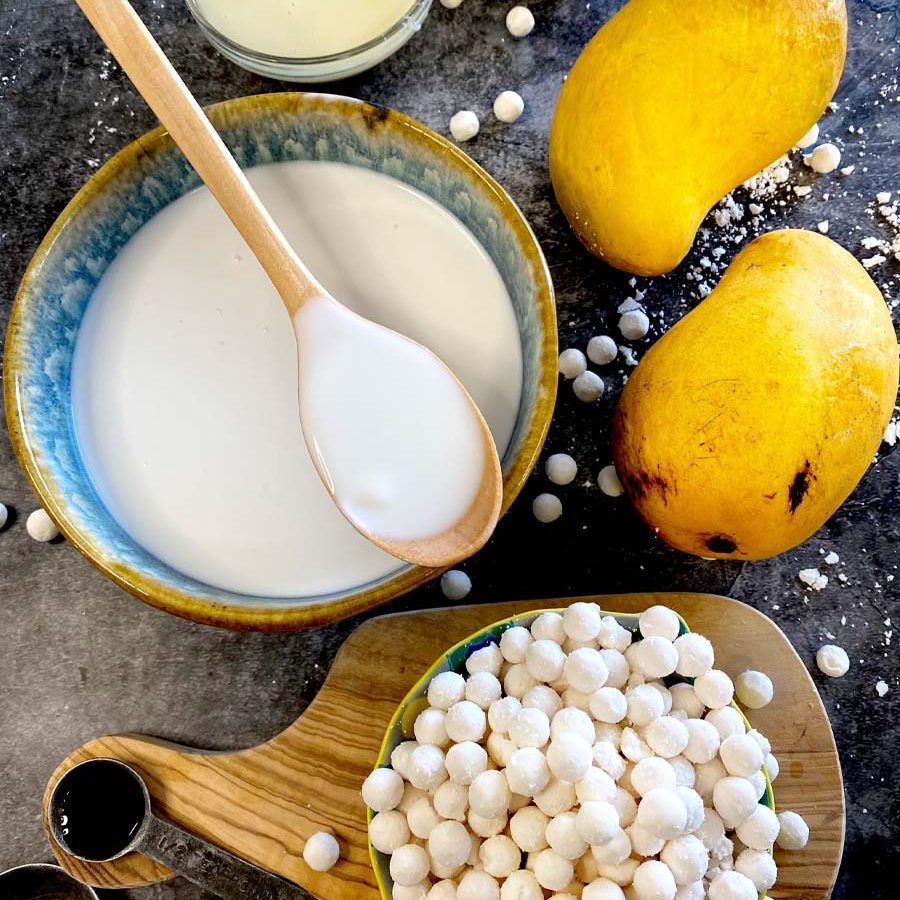This biko recipe with latik, also known as Filipino sticky rice cake, is so sticky, yummy delicious! This easy biko recipe will show you step-by-step how to make the best brown sugar coconut rice cake without a sticky pan! This includes the latik recipe to sprinkle all over the top for the best biko with latik! No fuss, no mess, and so good.

WATCH THE EASY STEP BY STEP VIDEO
Table of contents
Mom mom made biko all the time when I was growing up. My fingers, sticky with brown sugar, a child’s delight. Not only is this a yummy treat, but a nostalgic and memorable taste for me that reminds me of the sweet times.
Follow my through guide on how to make biko to enjoy this famous Filipino sweet delicacy.
What is Biko?
This amazing biko recipe features a traditional Filipino rice cake made from glutinous rice, coconut milk, and brown sugar.
It is one of the Filipino desserts that is often served during special occasions. This sweet delicacy is cherished during significant events such as birthdays, reunions, and fiestas, bringing joy and sweetness to these memorable occasions.
Don’t forget to share this with your friends!
The rice cake is sweet, sticky, and has a caramelized top layer and/or latik sprinkled all over the top of it, making it a popular, delectable dessert in the Philippines.
The coconut milk is subtle. The sweet is perfectly balanced, and the latik sprinkles add texture and crisp.
Biko with latik is so addicting! The latik is a must for me and you’ll love it once you try it all together.
Biko is a Kakanin
Kakanin refers to a variety of traditional Filipino rice cakes and desserts that are made primarily from glutinous rice, coconut milk, and sugar. These delectable treats come in various shapes, colors, and flavors, and they are often enjoyed as snacks or desserts in the Philippines.
Some popular types of kakanin include:
- Puto: Steamed rice cakes that are soft, fluffy, and slightly sweet. They come in different flavors and colors, such as white, purple, or yellow.
- Biko: A sticky rice cake cooked with coconut milk and brown sugar, resulting in a caramelized topping. It’s often garnished with toasted coconut flakes.
- Sapin-sapin: A layered rice cake made with coconut milk and rice flour, with each layer colored differently using natural food coloring. It’s usually topped with latik, a sweet coconut sauce.
- Bibingka: A type of rice cake cooked in banana leaves or clay pots, typically served during Christmas season. It has a slightly gritty texture and is often topped with salted egg, cheese, and grated coconut.
- Palitaw: Flat, chewy rice cakes that are boiled and coated with grated coconut and sugar. They are typically served as a snack or dessert.
These are just a few examples of the wide variety of kakanin enjoyed in Filipino cuisine. They are beloved for their unique textures, flavors, and cultural significance in Filipino food culture.
This recipe fully outlines BIKO for your next dessert creation.
What is Latik?
Latik is a traditional Filipino topping made from coconut cream that is simmered and reduced until the oil separates and the remaining solids are toasted to a golden brown color.
It’s crispy and a little chewy.
It’s very easy to make!
It doesn’t taste sweet by itself, but it perfectly compliments a sweet biko recipe.
It is then commonly used as a garnish for various Filipino desserts, adding a rich, nutty flavor and crispy texture to the dish.
In the context of the biko recipe, the latik is sprinkled all over the top of the rice cake, enhancing its overall taste and texture.
What’s Good About a Biko recipe?
- Beautiful, traditional Filipino dessert to show off the food culture of Philippines.
- Very few ingredients.
- Can be made overnight and in a large batch.
- Goes great for breakfast, potluck, parties, and family style eating.
- Compliments many Filipino dishes for a complete buffet.

Biko INGREDIENTS
- SWEET GLUTINOUS RICE – This is sold as “sweet rice” which is a short grain rice that has a high amount of starch, thus the “sticky” nature of this type of rice. It is GLUTEN FREE despite the name saying “glutinous”. Sweet rice can be found at Asian groceries.
- GOLDEN BROWN SUGAR
- REGULAR COCONUT MILK
- VANILLA EXTRACT – a dash elevates the brown sugar coconut mix
- SALT – the smallest pinch will do for balance
- PANDAN LEAVES – this adds aroma and has vanilla hints that elevate the rice. Optional if you cannot find this ingredient. Many Asian markets carry pandan leaves.
Latik Ingredients (topping)
- REGULAR COCONUT CREAM
EQUIPMENT
It is important to use a nonstick ceramic or similar style pan to make the biko and the latik. This will aid in the sauce not burning and keeping the method to make the recipe easier and mess free.
- NON-STICK PAN OR POT
- Wooden spoon or soft silicone spatula
- Pot – for rice
- Parchment Paper
- Platter or Pan for molding the biko
- Wire Mesh Strainer – to strain the latik
HOW TO MAKE this Easy Biko Recipe
Step 1: Make Coconut Rice
- Take one cup of sweet rice and put it in a pot. Most brands don’t require you wash the rice.
- Add a can of coconut milk.
- Add a tied up pandan leaf to the top of the rice. Cover with a very tight lid.
- Bring to a boil for three minutes.
- Lower the flame to very low so there is a very slight simmer/bubbling. 17 minutes. Be mindful that the lid is tight, the heat is very low, and that you taste the rice when it’s complete that it’s cooked throughly.
- Take the pot off the heat. Cover the lid with a kitchen towel to really trap in steam. Let the rice sit undisturbed for 12 minutes.
Here is more history and a detailed recipe for how to make on stove coconut rice.
Step 2: Make the Easy Biko Recipe
- Heat a packed cup of brown sugar in a pan over low heat.
- Add a two tablespoons of coconut cream.
- Melt the sugar and bring everything to a simmer. You will see the sugar begin to bubble. Keep the heat low so you don’t burn the sugar. Keep it bubbling and stir frequently.
- For the next 30-40 minutes, simmer the sugar mix and stir it very often with a wooden spoon or soft silicone spatula.
- Add a teaspoon of pure vanilla extract.
- Add a tiny pinch of salt. Just a very small amount, less than 1/8 of a teaspoon.
- Mix the brown sugar mix very well. Let it bubble, but keep the flame low.
- Add the coconut rice.
- Gently press the rice down and begin to mix and fold it with the brown sugar. Keep going until it is very evenly coated and every rice morsel is coated and separated.
Step 3: Mold the Biko
- Take a pan of choice and LINE it with parchment paper. It’s nice if the Filipino sticky rice cake is served not more than two inches high in thickness. This allows for area for the latik sprinkles on top! An inch and half is ideal so a pan that is about 9×13 or 7×10 is good.
- Pour the brown sugar Filipino stick rice cake mixture onto the parchment paper and very gently shape it in pan.
- Put parchment paper on top of the mixture so the top will be very flat and not have air touching it. It is important to seal the biko in the pan and not let air touch the biko so the recipe stays nice and moist.
- Refrigerate for six hours or overnight.
- Remove from the pan very easily by removing the top parchment paper and then flipping the pan over onto your platter. Revealed will be the delicious biko!
- Top generously with latik all over. Cut into big squares and serve by sliding a spatula under the slice and lifting up.
How to Make Latik
- Heat a can of COCONUT CREAM over medium heat.
- Stir periodically. The oil will begin to separate. Be patient and then the coconut cream will completely separate and the curds will begin to toast until they turn golden brown.
- Keep simmering until the curds become darker brown.
- Strain over a wire mesh strainer and you will be left with latik! Use this latik to sprinkle over the top of the biko. You can use your hands to crush it up a little for some of the chunky pieces.




Here is the detailed recipe for how to make latik and more about it.
STEP BY STEP IMAGES How to Make Biko











NOTES
For a perfectly chewy biko with a perfect latik topping, ensure the following tips are followed:
- Use a non stick pan
- Go low flame and slow simmer. Take your time.
- The mixture may seem very runny, but it will come together and become solid biko after it has rested and been refrigerated over many hours.
- Mix very well. Aim for perfectly separated and well coated rice when mixing the biko.
- Use Parchment Paper for the absolute easiest transfer and a clean presentation for your show stopping Filipino biko recipe.
- Biko MUST be refrigerated at least six hours to set.
- This recipe MUST have the fresh coconut milk…even if it is from a can…be sure the can is not close to the expiration date.
- Never over stir biko. Gently fold.
By following these tips, you can achieve a perfectly chewy biko with a delicious crispy latik topping.

ADD INS AND VARIATIONS
- Make a caramel to really take this easy biko with latik recipe to the moon. Heat 1/2 cup brown sugar with 1/4 cup coconut milk and simmer until thickened. Pour a very thin layer over the top of the biko before refrigerating.
- Condensed Milk Topping. Heat brown sugar with condensed milk until thickened and pour that over the top of the biko either before refrigerating or you can pour some over, warm, at the time of serving. Use a 1:1 ratio.
- You can add real, sweetened coconut shavings on top at the time of serving.
- More modifications can be using dark brown sugar for more sweetness. I actually like the level of sweetness with biko (it’s very sweet), but if you have that sweet craving you can go dark brown sugar style.
How to Serve Filipino Sticky Rice
- It is customarily presented on a bilao, a round wooden bamboo tray adorned with coconut-oiled banana leaves, adding a touch of nostalgia to the dining experience. You can buy banana leaves in circle shapes at the Filipino grocery or Asian markets.
- Serve this biko with latik recipe for breakfast with coffee or tea.
- Try this as a snack (merienda, meryenda) with more coffee or tea.
- Filipino biko is perfect for dessert.
- Biko is delightful served with brunch or at a potluck.
- If you’re like me, you can eat biko by itself anytime of the day!
Conclusion
Try this new, or old, recipe to you the next time you are craving something sweet and looking to sit down and savor the flavors of the Philippine islands. It sure is to add a smile to your day.
You can conveniently stay updated with the latest posts and access extra content by signing up to receive FREE new recipe posts directly to your email inbox.
Questions
Why is my rice hard?
When you make coconut rice, ensure the rice is cooked through perfectly and be sure to give it time to rest.
Add enough brown sugar mixture so that the biko recipe comes out well coated and moist. Dry biko is a result of not adding enough brown sugar mixture. The mixture should be runny and thick before it sets.
Cover the biko very well with parchment paper on top before refrigeration.
How do I store biko?
Wrap biko very well with parchment paper or plastic wrap before refrigeration to keep it moist. This easy biko recipe stores very well and stays moist because of the ratio of rice to sauce. Be sure to wrap it well to make it last a week.
Can I make the Biko dish in advance and store it before baking?
If you want a caramel topping to bake on the biko in addition to the latik, you can make biko the day before. Do as the instructions and when placing on top of the parchment paper in a pan, then also cover the top with parchment paper.
Be sure the top parchment paper is completely on top of the biko and pressed against it, sealing it away from any air. Reduce as many air bubbles as possible. Then add additional plastic wrap over the entire pan. This way the biko is still moist the following morning.
Then unwrap and make fresh latik for topping or add brown sugar coconut sauce (with a touch of butter and pinch of salt) poured thinly on top, bake it till gooey, then top with the latik.
How Many People can I serve with this recipe?
I eat a lot of biko! It’s that good, but I think if you have a table that has other desserts and more food then this recipe is perfect for a party of 5-10 people. If you have more than ten people I would definitely double the recipe.
Is biko gluten free?
Yes, this biko with latik recipe is gluten free! Rice, sugar, and coconut milk are gluten free.


Equipment
- NON STICK Pan for making the biko recipe
- pot for cooking rice
- Wooden Spoon or Soft Spatula stirring
- pan for molding the rice cake
- Parchment Paper
- wire mesh strainer to strain the latik from the coconut oil
Ingredients
Sticky Coconut Rice
- 1 cup Sweet Rice / Glutinous Rice
- 1 can Regular Coconut Milk
- 1 Pandan Leaf
Brown Sugar Sauce
- 1 cup Golden Brown Sugar
- 2 tbsp coconut cream
- 1 tsp Vanilla Extract
- 1 pinch salt just a tiny pinch
Latik Ingredient
- 1 can Regular Coconut Cream use the remaining amount (a little less than a can)
Instructions
Make Coconut Rice
- Take one cup of sweet rice and put it in a pot. Most brands don't require you wash the rice.1 cup Sweet Rice / Glutinous Rice

- Add a can of coconut milk.1 can Regular Coconut Milk

- Add a tied up pandan leaf to the top of the rice. Cover with a very tight lid.1 Pandan Leaf

- Bring to a boil for three minutes. Lower the flame to very low so there is a very slight simmer/bubbling. 17 minutes.

- Take the pot off the heat. Cover the lid with a kitchen towel to really trap in steam. Let the rice sit undisturbed for 12 minutes.

Make Biko Recipe Brown Sugar Mixture
- Heat a packed cup of brown sugar in a pan over low heat.1 cup Golden Brown Sugar, 2 tbsp coconut cream

- Add two tablespoons of the coconut cream (save the rest).Melt the sugar and bring everything to a simmer. You will see the sugar begin to bubble. Keep the heat low so you don't burn the sugar, but slow small bubbling is good. Stir frequently.

- For the next 30-40 minutes, simmer the sugar mix and stir it very often with a wooden spoon or soft silicone spatula.
- Add a teaspoon of pure vanilla extract.1 tsp Vanilla Extract, 1 pinch salt

- Add a tiny pinch of salt. Just a very small amount, less than 1/8 of a teaspoon. Mix the brown sugar mix very well. Let it bubble, but keep the flame low.

- Add the coconut rice.

- Gently press the rice down and begin to mix and fold it with the brown sugar. Keep going until it is very evenly coated and every rice morsel is coated and separated.

Mold the Biko Recipe
- Take a pan of choice and LINE it with parchment paper. It's nice if the Filipino sticky rice cake is served not more than two inches high in thickness. This allows for area for the latik sprinkles on top! An inch and half is ideal so a pan that is about 9×13 or 7×10 is good.

- Pour the brown sugar Filipino stick rice cake mixture onto the parchment paper and very gently shape it in pan.
- Put parchment paper on top of the mixture so the top will be very flat and not have air touching it. It is important to seal the biko in the pan and not let air touch the biko so the recipe stays nice and moist.

- Refrigerate for six hours or overnight. Refrigerate the leftover coconut cream.Remove from the pan very easily by removing the top parchment paper and then flipping the pan over onto your platter. Revealed will be the delicious biko!Now, time to make latik to sprinkle on top!

Make Latik
- Heat a can of COCONUT CREAM over medium heat. Bring to high Simmer.1 can Regular Coconut Cream

- Stir often. The oil will begin to separate. Be patient and then the coconut cream will completely separate and the curds will begin to toast until they turn golden brown.

- Keep simmering until the curds become darker brown.

- Strain over a wire mesh strainer and you will be left with latik! Use this latik to sprinkle over the top of the biko. You can use your hands to crush it up a little for some of the chunky pieces.

Serve Biko
- Sprinkle the toasted and crushed latik all over the top of the biko Filipino sticky rice. Cut in squares. Serve and enjoy!

Notes
- Wrap biko well with plastic wrap or parchment paper so it stays moist.
- When making the coconut rice, be mindful that the lid is tight, the heat is very low, and that you taste the rice when it’s complete that it’s cooked throughly. It should be perfectly soft but not mushy. It still has a little bite to it.
-
- Make a caramel to really take this easy biko recipe to the moon. Heat 1/2 cup brown sugar with 1/4 cup coconut milk and simmer until thickened. Pour a very thin layer over the top of the biko before refrigerating.
-
- Condensed Milk Topping. Heat brown sugar with condensed milk until thickened and pour that over the top of the biko either before refrigerating or you can pour some over, warm, at the time of serving. Use a 1:1 ratio.
-
- You can add real, sweetened coconut shavings on top at the time of serving.









Leave a Reply